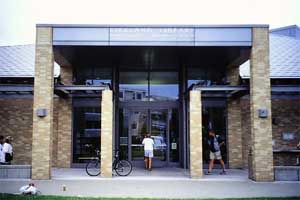On January 30, 1995, the Kirkland Library opens in its new location, which is adjacent to its old location in Peter Kirk Park. The new facility, built at a cost of $4.2 million and designed by Zimmer Gunsul Frasca Architects, provides much more space and many more borrowable materials than had the previous library, which was built in 1966. In 2009, the Kirkland Library will undergo another expansion.
Humble Beginnings
The Kirkland Woman's Club established the Kirkland Library in 1919. It consisted of a few bookshelves inside an office in the Kirkland State Bank. In 1925, the Woman's Club opened its own clubhouse, which also became the library's home for the next 20 years. In 1946, the library moved into a room at the new city hall, and the city of Kirkland assumed full financial support for the institution.
Post-war suburbanization brought more new residents to Kirkland and the library quickly outgrew its city-hall location. A new library was proposed in 1954, but work on a new facility didn’t begin until 1964, when voters approved a $175,000 bond issue for construction. In 1966, a new library building opened in Peter Kirk Park, east of downtown Kirkland.
In 1968, the Kirkland Library began contracting services from the King County Library System, and in 1990 voters approved its annexation to the King County Library System. By this time, the library had once again outgrown its current location. Planning soon began on a new facility.
Right Next Door
Rather than build a new structure in the same location, Kirkland officials chose a spot on the southwest corner of Peter Kirk Park, adjacent to the old library. The city also planned to build a $.5.5 million parking structure there, with the new library located on top. Most of the old library would later be torn down to make way for a new performing arts center, which retained a small portion of the library building as its back entrance.
In 1994, work began on the new 15,400-square-foot library, designed by Zimmer Gunsul Frasca Architects. To help establish a local identity for the new building, the Friends of Kirkland Library asked people to buy a brick with their name on it, for the front entrance plaza. Proceeds from the sale were used to purchase books and materials not covered in the library budget.
The $4.2 million project was completed by the end of the year, and the new building's proximity to its old location made moving books and materials that much easier. More than 20,000 new books were added to the collection. The new library also contained 16 computers for public use, and plans were in the works to offer lessons to patrons on how to use the Internet. A new Kirkland Library sculpture garden displayed works loaned by artists for six months at a time; it would draw visitors from as far away as Russia and Argentina.
Grand Opening
More than 900 people showed up on January 30, 1995, for the library's grand opening. Whereas the old library had been cramped and somewhat dark, the new library was spacious and well lit, with floor-to-ceiling windows facing out toward the baseball diamond in Peter Kirk Park.
Many visitors that day spent time in the plaza looking for their "subscriber" bricks, and admiring the statues and artwork placed in and around the building. But most people wanted to be the first to check out books, compact discs, and videos. In all, more than 5,000 borrowed items left the library that day, about twice the normal checkout rate.
Parking at the new library was also easier, now that there was a garage beneath it. The old library had only had space for a few dozen cars, but the Peter Kirk Municipal Parking Garage had 420 parking spaces, free of charge for up to four hours. The garage also acted as a hub for the city's new transit center, and all day long buses came and went next to the library.
In 2009, the building was expanded by more than 4,500 square feet as part of King County Library System's Capital Improvement Plan -- funded by a voter-approved capital bond in September 2004. The library now provided a larger children's area, new meeting rooms, and study rooms. More than 5,000 new books, magazines, movies, and CDs were added to the collection.

